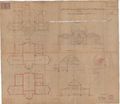Difference between revisions of "Category:Fabiani heritage"
(Created page with "Architecture Monuments and sites") |
Anže Zorman (talk | contribs) |
||
| Line 1: | Line 1: | ||
| + | [[Maks Fabiani]] (1865–1962) was born in Kobdilj, a hamlet in the Slovenian Karst region. He conducted his studies and also a big part of his career in Vienna, where he attained his doctorate on urban planning, worked as a professor at the university and was the founding member of the Austrian Society for Architecture and the president of the Austrian Society of Engineers and Architects. For a time, he worked as an urban advisor at the Viennese Interior Ministry and was later Franz Ferdinand's counsellor for architecture and history of art and urbanism. Fabiani also worked with Otto Wagner for a few years and together they co-wrote the much acclaimed book Modern Architecture and worked together on Wagner's Vienna Electronic City Railway project. | ||
| + | |||
| + | Fabiani operated his own architectural studio in Vienna between 1896 and 1917 and during that time he was commissioned for a number of elite projects in the Habsburg Empire, the still iconic Viennese buildings Artaria, Urania and Portois&Fix among them. His projects of that time also include Franz Ferdinand's mansion at Brioni, the renovation of the Konopište Castle, the Casa Bartoli palace in Trieste, and the "Spas for civil servants" in Opatija. | ||
| + | |||
| + | Besides Vienna, Ljubljana bears the mark of Fabiani most strongly. In the aftermath of the 1895 earthquake that destroyed much of the city, Fabiani's report was actually the first text on urban planning in Slovene language. Though this plan was not endorsed as such, most of its ideas were implemented and the present day Ljubljana still displays its logic. Some of his important works in Ljubljana are Krisper House, Hribar House and Bamberg House, the Mladika building, Miklošič Park and partly also Prešeren Square. | ||
| + | |||
| + | He left Vienna in 1917 and after that based most of his projects in Slovenia and Italy. He took over the renovation of the war-torn Posočje, Gorica and Karst region in the years 1917–1922 and was later the chief architect and urban planner for Gorica, where he stationed his studio until his death. | ||
| + | |||
[[Category:Architecture]] | [[Category:Architecture]] | ||
[[Category:Monuments and sites]] | [[Category:Monuments and sites]] | ||
Revision as of 14:54, 3 November 2015
Maks Fabiani (1865–1962) was born in Kobdilj, a hamlet in the Slovenian Karst region. He conducted his studies and also a big part of his career in Vienna, where he attained his doctorate on urban planning, worked as a professor at the university and was the founding member of the Austrian Society for Architecture and the president of the Austrian Society of Engineers and Architects. For a time, he worked as an urban advisor at the Viennese Interior Ministry and was later Franz Ferdinand's counsellor for architecture and history of art and urbanism. Fabiani also worked with Otto Wagner for a few years and together they co-wrote the much acclaimed book Modern Architecture and worked together on Wagner's Vienna Electronic City Railway project.
Fabiani operated his own architectural studio in Vienna between 1896 and 1917 and during that time he was commissioned for a number of elite projects in the Habsburg Empire, the still iconic Viennese buildings Artaria, Urania and Portois&Fix among them. His projects of that time also include Franz Ferdinand's mansion at Brioni, the renovation of the Konopište Castle, the Casa Bartoli palace in Trieste, and the "Spas for civil servants" in Opatija.
Besides Vienna, Ljubljana bears the mark of Fabiani most strongly. In the aftermath of the 1895 earthquake that destroyed much of the city, Fabiani's report was actually the first text on urban planning in Slovene language. Though this plan was not endorsed as such, most of its ideas were implemented and the present day Ljubljana still displays its logic. Some of his important works in Ljubljana are Krisper House, Hribar House and Bamberg House, the Mladika building, Miklošič Park and partly also Prešeren Square.
He left Vienna in 1917 and after that based most of his projects in Slovenia and Italy. He took over the renovation of the war-torn Posočje, Gorica and Karst region in the years 1917–1922 and was later the chief architect and urban planner for Gorica, where he stationed his studio until his death.
Articles in category "Fabiani heritage"
The following 7 pages are in this category, out of 7 total.
Media in category "Fabiani heritage"
The following 13 files are in this category, out of 13 total.
- Maks Fabiani Foundation 1907 Slovenski trg.tif 1,150 × 1,747; 5.77 MB
- Maks Fabiani Foundation 1908 Jakopic Pavilion sketch 1.jpg 5,138 × 2,503; 20.25 MB
- Maks Fabiani Foundation 1908 Jakopic Pavilion sketch 2 .jpg 5,138 × 2,561; 20.34 MB
- Maks Fabiani Foundation 1908 jakopi pavilion sketch.jpg 9,213 × 8,000; 16.44 MB
- Maks Fabiani Foundation 2011 Maks Fabiani exhibition at Stanjel Castle.JPG 6,000 × 4,000; 6.13 MB
- Maks Fabiani Foundation 2015 Good-bye Vienna, Hello Stanjel exhibition.JPG 6,000 × 4,000; 6.44 MB
- Maks Fabiani Foundation - Maks Fabiani portrait.JPG 4,916 × 6,895; 7.83 MB
- Piran Days of Architecture 2016 Piran City Gallery exhibition Photo Jadran Rusjan.jpg 5,472 × 3,648; 2.54 MB
- Stanjel Castle 2020 Exterior Photo Kaja Brezocnik.jpg 2,048 × 1,365; 1.52 MB















